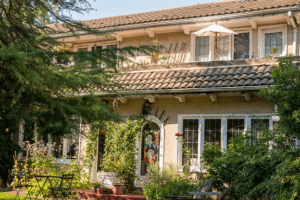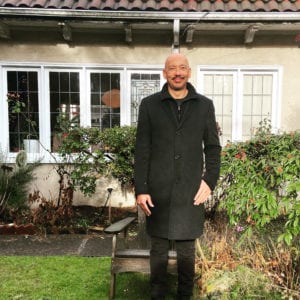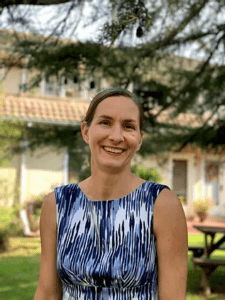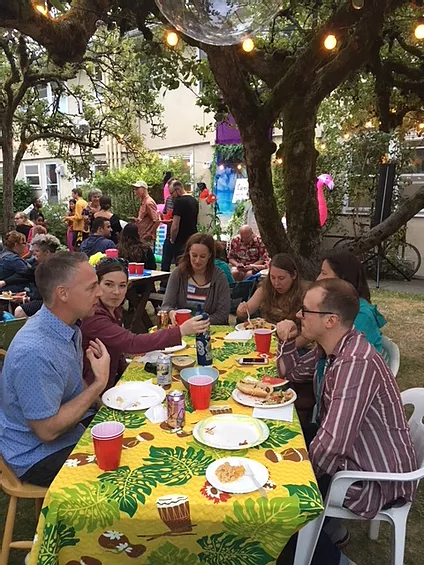¡Viva La Quinta!
Talk to anyone who has ever been a La Quinta Apartments resident about what it’s like to live in this Frederick Anhalt-developed building on Capitol Hill (1710 E Denny) and you will immediately hear stories of connection, accounts of really knowing your neighbors, and descriptions of a very close-knit community.
“La Quinta is a unique place where all of the neighbors grow close and really like spending time together… all of the people I have met there seem to genuinely want to make the place they live not just a home for themselves, but also a community where people look out for each other and become family,” said a friend of a La Quinta resident since the 1990s.
You may also hear descriptions about the magic of the courtyard, shared balconies, charming turrets, and a unique design that welcomes interaction.
“La Quinta is more than just gorgeous architecture. It’s a perfect place to be a writer, with plenty of beauty and solitude balanced with a supportive community just outside my door.” said Chelsea Bolan, a La Quinta resident since 2003.

La Quinta Apartments from the courtyard. Photo by Jesse L. Young, Seattle.
Given all of this, it is no wonder why a group has come together with a well-coordinated effort to seek protections for this extraordinary place. Formed in late 2020, ¡Viva La Quinta! is a group of residents, neighbors, and allies (including Historic Seattle) dedicated to preserving La Quinta Apartments and making it a City landmark.
This month, we took the opportunity to talk to two people involved in ¡Viva La Quinta! Lawrence Norman, who grew up at La Quinta in the ‘60s, shares his unique connection to the place and the influence it had on his life trajectory. Chelsea Bolan describes what it’s like to live there today and tells us more about the group working to preserve La Quinta for generations to come.
“Born” at La Quinta: Lawrence Norman & Seattle’s First Black-Owned Computing Business
“My father was a Black man and from Mississippi and my mother was a White woman from Alabama – they met at Boeing. He was an aeronautical engineer, and she was a mathematician and computer programmer. She actually programmed some of the first satellites!” said Lawrence Norman describing his origins at the La Quinta Apartments. He continued, “To an extent, I think some of the reasons they came to Seattle were to get as far away from the South as possible. They were pretty idealistic, and, at the time, Seattle was pretty radical.”
While It may have been radical in some ways, during that time (the mid-1960s) Seattle and many other “progressive” cities exercised an intentionally discriminatory practice known as “redlining.” In this practice, White people wrote racial exclusions into property deeds and community covenants, effectively prohibiting property ownership for Black people, Jews, and other people of color, beyond very limited areas bound by red lines.

Image from “The History of Redlining” by KCTS9 on YouTube.
Despite this very significant obstacle, Lawrence’s father Richard worked to purchase the La Quinta apartments by making a deal directly with the property owner at the time. “When he bought La Quinta in…1964, or 1965, it was just over the ‘red line,’” Lawrence explained. According to Lawrence, Richard was not new to real estate. “He had previously owned a property in the ‘Negro area,’ (as defined by redlining) and he’d owned another right on the line,” Lawrence says. Given the practices of those times, it is not surprising that Richard’s ownership had been reflected as a gap in the official records. You can read more about this, and other interesting aspects of the building’s ownership history in the landmark nomination report here.
Lawrence added, “My parents worked together at Boeing for a few years before starting a computing business out of La Quinta. Apartment 9 was home, and Northwest Computing was basically a startup, born out of apartment 10 — In 1965 of all things! I imagine it was probably the first Black-owned computing business in Seattle, but I can’t say for sure. The business lasted for like 8 or 9 years and it was pretty successful, with up to 18 or 19 employees at one point and an office downtown. But then the Boeing bust happened, and we lost it all. It was a painful time. That place is special to me and represents something totally personal.”

A turret at La Quinta. Photo by Jesse L. Young, Seattle.
Some of Lawrence’s earliest memories are from La Quinta. “I remember looking out of the turret into the courtyard from my room, and there were other kids there. I remember one in particular, a little girl who lived in apartment 4. Her room was also in a turret and I had a crush on her, it was pretty cute,” Lawrence recalled. “The community was tight-knit, there was an ease with the architecture. It’s a U-shaped building with everyone facing each other around the courtyard, making it almost like a little village. It’s also a refuge, peaceful and conducive to conversation. My dad was very serious about keeping that courtyard in good shape!”
Because of the Boeing bust Lawrence left La Quinta at age 7, but his time there would shape him in many ways and play into some of his life choices. “The Boeing bust was very real for me and my family. Losing La Quinta set me up to be more conservative in my own life,” he explained.

Lawrence Norman at La Quinta, age 7. Courtesy of Lawrence Norman
Lawrence would follow in his parents’ footsteps by pursuing a career in software. “I got a Bachelor of Science in Computer Science while I was at Evergreen, but I got distracted for a year by Architecture. When I ask myself why I was drawn to study architecture, I’d say it probably came from living in that building,” said Lawrence.

Lawrence at La Quinta in 2020.
Lawrence went on to compare software design and architectural design citing A Pattern Language, a popular book often included in both courses of study. “The book looks at everything from the big design down to a doorknob and asks, ‘what’s the optimal design for human functionality?’ I think La Quinta represents a ton of those design patterns. And when you get really geeky, you know that design patterns are also part of software design! Whether you’re trying to design a user interface or housing where people can coexist, some designs invite human interaction and some detract from it. The question is, ‘how do you want to structure these things so human beings can have the best experience?’ It applies to software, it basically applies to anything you’re building.”
In summarizing why La Quinta should be protected, Lawrence said, “It’s a unique piece of architecture whose scale and design promotes bonding between neighbors, and I’d like to see historical designation for it so that it could maintain its natural affordability instead of maximizing buildable volume.”
A Legacy of Community: La Quinta Today, and Hopes for its Future – Chelsea Bolan

Chelsea Bolan, one of the founders of ¡Viva La Quinta! and resident since 2003.
¡Viva La Quinta! member Chelsea Bolan came to Seattle from Spokane in the 1990s to attend UW. She lived all over Capitol Hill in her early days here and remembers always admiring La Quinta and thinking “one day, if I could ever afford it…” In 2003, that day came, and Chelsea’s life has taken shape around La Quinta ever since.
“When I first moved in, I treated it like any other apartment building, where you’d be like, ‘Oh hi, nice to meet you,’ and go inside and never talk to your neighbors again. Within days, we had neighbors knocking on our door saying, ‘We’re having a BBQ, do you want to come out?’ and I just thought ‘Wow, this is amazing!’ I’d never had an apartment experience like that, with people who are really interested and really want to get to know you. That aspect of liking your neighbors, of being able to talk to your neighbors, and actually being friends – that has never changed since I’ve been here. One thing I’ve learned from this project (¡Viva La Quinta!), from talking with other people who lived here in the past, is that it was always this way,” said Chelsea.

Movie night in the courtyard.
“We have a lot of traditions and gatherings within, among just us and our friends. Sometimes it’s centered around food, like when we all made tamales together in a big assembly line in Aaron and Marta’s apartment, then ate them in the courtyard garden. We have one tradition that was started by someone who no longer lives here, someone who left over ten years ago. It’s based on the 12 days of Christmas since there are 12 apartments. It’s a roaming party where we spend 20 minutes in each person’s apartment, which is now organized by a neighbor who wasn’t even here when it got started. It’s gone on for years now and it’s interesting that it still works. The people change, but it’s always a mix of people who are interested in these things. I wonder if it’s the architecture that brings people out, because by design, we share so much space. I think the building just draws a certain kind of people too, people who are open to talking to each other.”
“There’s a lot of community within, but it extends out into the neighborhood and larger community in a lot of ways too. One example is our annual BBQ. Every year, we have a free community BBQ that is a fundraiser for a local nonprofit. We invite everyone in the neighborhood. People love it, and it’s a great opportunity to meet new neighbors.”

A community gathering at La Quinta.
In describing how ¡Viva La Quinta! came about, Chelsea said, “We heard from the apartment manager that the building was going to be coming up for sale. He wanted to let us know, in case we wanted to landmark it before it got sold. We said, ‘We’ve got to get on this!’ Someone sent an email around and we started planning. Word spread and neighbors came forward saying ‘We can help, we’ve done this before, we can put you in touch with the right people,’ and they connected us to Historic Seattle and then Historic Seattle contacted Northwest Vernacular (the firm that wrote the landmark nomination). It’s amazing, among us we have architects, photographers, writers, people who know how to build a website and do graphic design. Everyone just naturally came into a role, and it all came together. It was actually Jeff (Murdock, Historic Seattle’s Advocacy & Education Manager) who came up with the name ¡Viva La Quinta! It really captures the spirit we have, this lively spirit. And also, ‘Long live!,’ let’s keep this thing going!”
On why she thinks the La Quinta Apartments should be protected, Chelsea added, “The community that the place fosters is a big part of it, but it’s also just a great building. With its Spanish style, it is unique even among Anhalt designs. He made it feel like a home, more than just an apartment. There’s a thought toward individuality, every apartment is different, and there’s a lot of thought to detail from the layout to the fixtures. The courtyard too is valuable, especially as greenspace becomes more and more limited. It has provided so much to us during the pandemic. Both the community and the architecture are really important to preserve.”
Both Lawrence and Chelsea thought a co-op or a condominium ownership model would be beneficial in the long-term. “My dream for the place would be that everything that needs updating and attention would be fixed, and that after all of that, it would still be affordable.”
¡Viva La Quinta! Get involved!
Because of its significance to the community, Historic Seattle has prioritized the La Quinta as a major advocacy effort. A landmark nomination was submitted in October 2020. The Seattle Landmarks Preservation Board will consider the nomination at its February 3 public meeting.
You can help support the La Quinta preservation efforts! The ¡Viva La Quinta! website, created and maintained by the residents, is a great resource. Stay connected through the ¡Viva La Quinta! email list and Instagram. If you already follow Historic Seattle via eNews, Facebook, and/or Instagram then you’ll stay in the know as well.